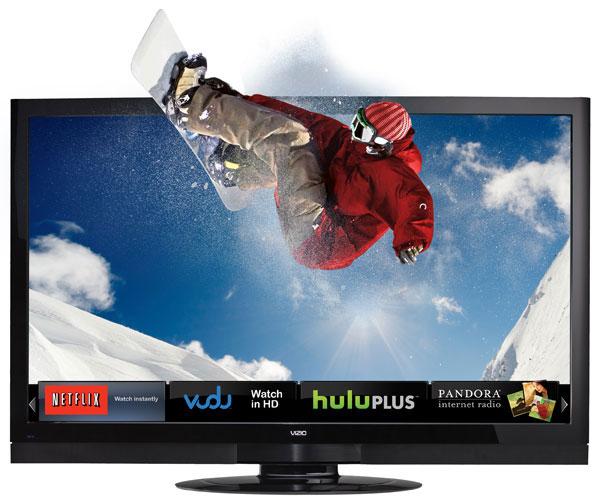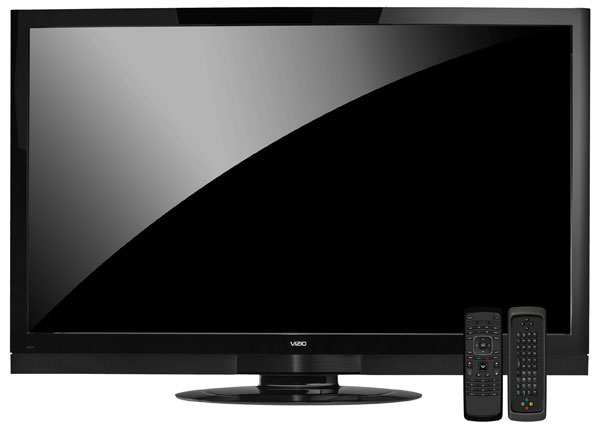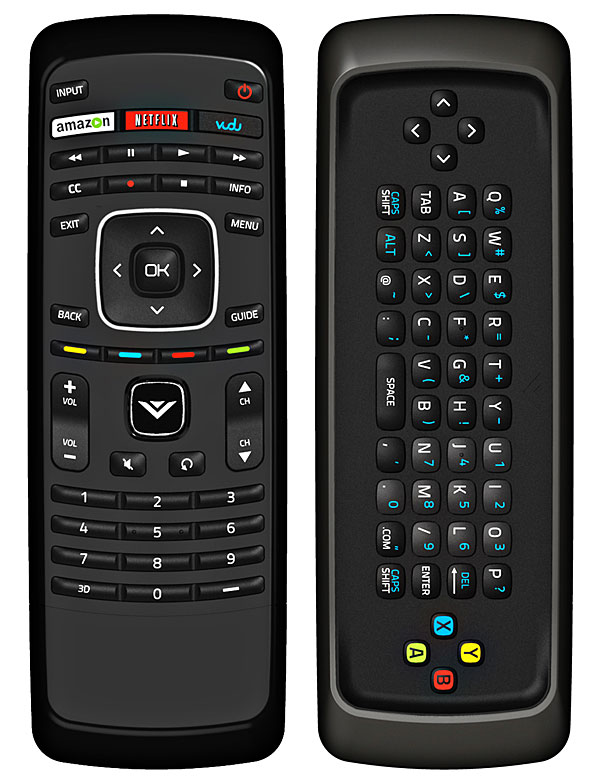Vizio M3D650SV 3D LED-LCD TV

When Tom Norton reviewed the 65-inch Vizio XVT3D650SV 3D LED-edgelit LCD TV last year (see review here), he found it to be an excellent performer in most respects. However, its list price of $3,700 kept many potential buyers away—and, along with the few problems he did find, kept him from bestowing HT's Top Picks designation.
Fast forward a year. Vizio has now added a virtually identical set to its midrange M series, the M3D650SV, with a dramatically reduced list price of $2,200 and a street price likely to be well under two grand. If it performs as well as its progenitor—and improves on the few shortcomings—it could be a slam dunk for those who want a bigger-than-most 3D flat panel that won't break the bank.
Features
At 65 inches diagonally, the M3D650SV's screen is larger than most flat panels these days, which is especially important for 3D. Speaking of which, all Vizio 3DTVs use the passive approach, with passive-polarized glasses that are much lighter and less expensive than active-shutter glasses and require no batteries. The M3D650SV comes with four pairs of glasses, and additional pairs are $25 each or $45 for a 2-pack. You can also use the Vizio glasses at any RealD 3D movie in a commercial cinema, but not Imax 3D.
How does passive 3D work? The TV's screen includes a layer that polarizes alternating horizontal lines, so the left eye sees every other line while the right eye sees the lines that the left eye doesn't. This presents only 540 lines to each eye, but Vizio and others—including DisplayMate, an independent video-consulting firm—claim that the brain fuses the two images together into a single, 3D image with all 1080 lines. (See DisplayMate's report on this here.)

Vizio Internet Apps (VIA) offer access to a wide variety of online content from providers such as Netflix, Vudu, Hulu, Amazon On Demand, and many others, as well as social-media apps like Twitter and Facebook. The set comes preloaded with quite a few apps, and you can download lots more from the Yahoo Media Store. If you don't have a convenient Ethernet access point near the TV, it has built-in WiFi, though streaming high-def video is more reliable with a wired connection.
Unlike Vizio's higher-end LED-backlit LCD TVs, which have a full array of LEDs behind the screen, the M3D650SV uses LEDs along the edges of the screen to illuminate the image. The company claims that its Smart Dimming technology controls different blocks of LEDs to achieve darker blacks and greater uniformity.
For those who use the TV's onboard sound, the M3D650SV provides SRS StudioSound, which includes TruVolume to even out volume inconsistencies between programs and commercials. Another element of StudioSound is TruSurround HD, which is said to simulate a surround-sound system. Overall, I found the onboard sound to be reasonably good—in fact, better than most TVs—though as always, I prefer a good outboard sound system.
Ergonomics
The two-sided remote has a relatively conventional button layout on one side and a QWERTY keyboard on the other. The buttons on the standard-remote side are reasonably well organized, but most buttons are the same small size and shape and not well separated, including the transport buttons for online content, making it difficult to operate in the dark, especially since it's not illuminated. There are dedicated buttons for Amazon On Demand, Netflix, and Vudu, and a central button with the Vizio logo displays the apps across the bottom of the screen.
The QWERTY side includes a cursor cluster on the left and four color-coded VIA Shortcut Buttons on the right that can control the Internet apps. Like the standard-remote side, the QWERTY side communicates with the TV via infrared (IR), so you must aim the remote at the TV and not cover the IR emitter with your finger, as I did at first. For this application, a radio frequency (RF) or Bluetooth connection that eliminates the need to point the remote would have been a better option.

Pressing the Menu button brings up nine onscreen icons with the Picture menu selected by default. This type of organization requires an extra button push just to get into a menu. Once you're in the Picture menu, you see the basic picture controls and a More option at the bottom that brings up three submenus—Size & Position, Color Temperature, and Advanced picture—which you must then also select independently to open.
The good news is that the menu does not time out—it stays on the screen until you exit. This is especially welcome when making picture adjustments. Unfortunately, when you adjust any picture control, it is displayed not at the bottom of the screen, but close to the center, obscuring setup and measurement patterns or the image if you're trying to tune with program material. All in all, the M3D650SV's menu required too many button pushes to navigate, and I found it clumsy and poorly laid out.
Setup
The basic picture settings for each picture mode and for 2D and 3D mode are independent for each input. This means you can set up, say, Movie mode differently for 2D and 3D coming into a given input, and those settings can be different still for other inputs. However, the color-temperature presets—and any tweaks you make to them to even out the grayscale tracking—are applied to all picture modes as well as 2D and 3D for any given input.
This caused some problems when calibrating the HDMI input I used for my 2D/3D Blu-ray player, in that it would automatically select only one color-temperature preset optimized for either 2D or 3D. My solution was to start with the picture mode that exhibited the best out-of-box grayscale and color accuracy—Movie mode—for the basic video settings for both 2D and 3D. Then, I tuned the Normal color-temp preset for optimum 2D viewing. For 3D, I separately tuned the Custom color-temp preset.
With this arrangement, when the TV was set to play 2D content from the Blu-ray player, it defaulted to the correct basic settings and color-temp preset for 2D. When it was set to play 3D, it switched to my basic video settings for 3D, but it stayed on the Normal color-temp settings. I had to manually select the Custom color-temp preset in the menu whenever I was watching 3D, then switch back again afterward. This was a real drag, and I implore Vizio to make the color-temp presets behave like the picture-mode presets in this regard.
That issue aside, the Vizio's Movie mode had a reasonably accurate grayscale out of the box that I was able to improve further with calibration. But the colors measured noticeably off the industry HDTV standard (see "HT Labs Measures") for the red, green, and blue primary colors. With no color management system (CMS) available in this set to adjust the color points, they remained that way even after calibration. Fortunately, this seemed to have little effect on real program material.
As with most 120Hz LCD TVs, this one provides frame interpolation—sometimes called motion estimation/motion compensation, or MEMC—which estimates where moving objects would be in frames between the incoming frames and then synthesizes those intervening frames. This sharpens motion detail, but it also introduces an artifact called the "soap-opera effect," so called because it makes movies look like they were shot on video like a soap opera. It can also make certain areas of fine detail look smudged.
Many people object to this artifact more than they like the sharpened motion detail, but I'm not one of them—I prefer to see sharper motion, and the soap-opera effect doesn't bother me all that much. I found that the Smooth Motion Effect (Vizio's name for MEMC) sharpened motion quite a bit at the Low setting without any smudging, and it didn't improve much at higher settings, so I left it at Low.
2D Performance
I started my 2D watching with Stargate: Continuum on Blu-ray. Turning Smart Dimming on made the black of space in the opening starfield darker, but it still wasn't tremendously deep. Also, the uniformity of this and other dark scenes was not all that great—it was darker in the center and lighter in the corners, a phenomenon sometimes called "spotlighting," which is common with LED-edgelit LCD TVs. The severity of this effect was about the same as I've seen in other LED-edgelit LCD TVs, though it was more diffuse than in some sets.
Detail was nice and sharp in things like the sand surrounding the Tokra city and the texture of clothing, and despite the slightly inaccurate color measurements, colors were surprisingly natural, including skin tones. Shadow detail in the scene with the Achilles steaming across the Atlantic at night was pretty good with Smart Dimming on and slightly better with Smart Dimming off, but that also washed out the image a bit. And although I generally prefer to turn off all picture "enhancements," I found that Adaptive Luma actually improved shadow detail—a setting of Medium was better than Low, and Strong wasn't much different, so I used Medium with Smart Dimming on for the rest of my viewing.
I did some more evaluation of shadow detail with Master & Commander on Blu-ray. A great test for this is the opening scene with a watchman walking below deck at night—on the Vizio, the shadow detail in this scene was quite good with Smart Dimming on and Adaptive Luma set to Medium. However, the letterbox bars were fairly visible and lighter in the corners than in the center. Smart Dimming never turned the LEDs completely off, even in the black interstitial screens.





























































